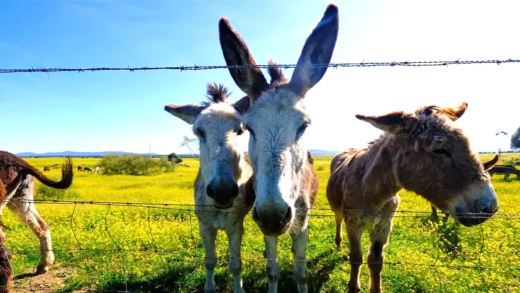The thorny devil is a fascinating lizard known for its spiky appearance and unique adaptations. It thrives in the harsh Australian deserts by using camouflage and specialized behaviors to avoid predators and collect water. Its remarkable features and behaviors highlight the resilience of this extraordinary creature.
Thorny Devil Overview: What is this unique creature?
The thorny devil is a remarkable lizard native to Australia, distinguished by its spiky appearance and fascinating adaptations. This small reptile, averaging around 20 centimeters in length, has a body covered in sharp, thorn-like spikes that serve not only as a defense mechanism against predators but also as a means to regulate its body temperature. The thorny devil’s unique features make it one of nature’s most interesting survivors.
One of the key characteristics of the thorny devil is its ability to change color based on temperature, which helps it blend into its surroundings. This camouflage is essential for avoiding predators in the harsh Australian desert. Additionally, the thorny devil has a distinctive appearance with a rounded body and a flattened head, which further enhances its ability to evade capture.
In summary, the thorny devil is an extraordinary creature that showcases the wonders of evolution and adaptation, making it a true icon of the Australian wildlife.
Habitat of the Thorny Devil: Where does it live?
The thorny devil primarily inhabits arid and semi-arid regions of Australia, particularly in areas like the Australian deserts and scrublands. Its preferred habitats include sandy or rocky environments where it can easily camouflage itself among the natural landscape. This lizard is commonly found in regions such as the Great Sandy Desert and the Gibson Desert, where the climate is hot and dry.
In these habitats, the thorny devil exhibits fascinating behaviors to adapt to its surroundings. It often buries itself in the sand to escape the extreme heat of the day, emerging during cooler periods. The thorny devil’s habitat not only provides it with protection from predators but also offers the necessary resources for survival, such as insects for food.
In conclusion, the thorny devil thrives in harsh desert environments, showcasing its remarkable ability to adapt and survive in some of the most challenging habitats on Earth.
How the Thorny Devil Drinks Water: The art of water collection without movement
One of the most intriguing aspects of the thorny devil is its unique method of drinking water. Unlike many animals that require access to standing water, the thorny devil has developed a remarkable technique to collect moisture directly from its environment. This lizard can absorb water through its skin and specialized grooves that channel moisture to its mouth.
When it rains or when dew forms, the thorny devil positions itself in a way that allows water to flow into its mouth through these grooves. This adaptation is crucial for survival in its arid habitat, where water sources are scarce. By remaining still and using its body to gather moisture, the thorny devil can hydrate without expending energy.
In essence, the thorny devil’s water-drinking method exemplifies its extraordinary adaptations to desert life, allowing it to thrive in an environment where water is a precious resource.
Unique Features of the Thorny Devil: What Sets It Apart?
The thorny devil is equipped with several unique features that enhance its survival in the wild. First and foremost, its spiky body not only serves as a defense mechanism against predators but also helps in regulating its body temperature. The spikes create a larger surface area, allowing for better heat dissipation during the scorching Australian sun.
Another fascinating characteristic is its ability to change color. This adaptation is crucial for camouflage, enabling the thorny devil to blend seamlessly into its surroundings, particularly in the sandy desert environments where it resides. When threatened, it can also flatten its body, making it appear less conspicuous to potential predators.
Moreover, the thorny devil possesses a unique feeding mechanism. Its tongue, which is sticky, allows it to capture ants and other small insects with precision. This adaptation is vital since its diet primarily consists of ants, making it a specialist feeder.
- Spiky body for defense and temperature regulation.
- Color-changing ability for camouflage.
- Flattened body posture to avoid detection.
- Sticky tongue for efficient feeding on ants.
In conclusion, these unique features not only help the thorny devil survive but also make it a fascinating subject of study in evolutionary biology.
The Devil Lizard Nickname: Why Is It Called That?
The nickname devil lizard stems from the thorny devil’s distinctive appearance and its formidable defenses. The spikes covering its body give it an intimidating look, reminiscent of medieval armor. Additionally, the lizard’s unique behavior and adaptations contribute to its devilish persona.
Many indigenous Australians refer to this creature as “Moloch” which is derived from ancient languages. This name, associated with a deity known for its fearsome qualities, reflects the lizard’s spiky exterior and its ability to survive in harsh conditions. The name “devil” adds an element of intrigue, highlighting its otherworldly appearance and remarkable adaptations.
- Spiky appearance resembling armor.
- Indigenous name “Moloch” connects to ancient deities.
- Intriguing behaviors enhance its devilish image.
Thus, the nickname not only captures the lizard’s striking looks but also its impressive survival capabilities in the unforgiving Australian desert.
Desert Adaptations: How Does It Thrive in Harsh Conditions?
The thorny devil has evolved several remarkable adaptations that enable it to thrive in the harsh desert conditions of Australia. These adaptations are critical for its survival in an environment characterized by extreme temperatures and limited water availability.
One key adaptation is its ability to regulate body temperature through behavioral changes. The thorny devil often burrows into the sand during the hottest parts of the day, emerging when temperatures are more manageable. This behavior minimizes exposure to the sun’s intense rays.
Additionally, the thorny devil’s skin plays a vital role in its survival. The lizard has specialized grooves on its body that allow it to collect and channel moisture from rain or dew directly to its mouth. This unique method of water collection is essential for hydration in an environment where water sources are scarce.
- Burrowing behavior to escape heat.
- Specialized skin grooves for moisture collection.
- Ability to remain still to conserve energy.
In summary, the thorny devil’s desert adaptations exemplify the ingenuity of nature, showcasing how life can endure in even the most challenging conditions.
Predator Avoidance: Using Appearance for Safety
The thorny devil employs its unique appearance as a formidable defense mechanism against predators. Its spiky body not only creates an intimidating silhouette but also serves to deter potential attackers. When threatened, the thorny devil can flatten its body against the ground, making it appear even less conspicuous. This behavior, combined with its ability to change color, allows it to blend seamlessly into the desert landscape.
Moreover, the thorny devil relies on its passive defense strategy rather than active flight or fight responses. Its spikes can also give the impression of a larger and more formidable creature, which can be enough to dissuade smaller predators. The combination of its visual adaptations and behavioral strategies highlights the thorny devil’s incredible ability to survive in a harsh environment where predators are a constant threat.
- Flattening behavior to reduce visibility.
- Color-changing capability for effective camouflage.
- Spiky body structure as a deterrent against predators.
In summary, the thorny devil’s appearance not only aids in camouflage but also plays a crucial role in its survival strategy, allowing it to navigate the dangers of the desert.
Interesting Behaviors: Unique Habits of the Thorny Devil
The thorny devil exhibits several fascinating behaviors that go beyond its remarkable water collection methods. One such behavior is its unique feeding strategy. This lizard primarily feeds on ants, using its sticky tongue to capture its prey effectively. The thorny devil’s diet is specialized, allowing it to thrive in its arid habitat where other food sources may be scarce.
Another interesting aspect of the thorny devil’s behavior is its social interactions. While primarily solitary, these lizards may engage in territorial displays, where they puff up their bodies and display their spikes to ward off intruders. This behavior not only helps maintain their territory but also showcases their impressive physical adaptations.
Additionally, the thorny devil can remain motionless for extended periods, which not only aids in predator avoidance but also conserves energy in the extreme heat of the desert. This ability to stay still, combined with its other adaptations, makes the thorny devil a master of survival.
- Specialized feeding on ants with a sticky tongue.
- Territorial displays to assert dominance.
- Ability to remain still for energy conservation.
In conclusion, the thorny devil’s interesting behaviors further emphasize its remarkable adaptations, allowing it to thrive in one of the most challenging environments on Earth.
Conclusion: The Resilience of the Thorny Devil
The thorny devil stands as a testament to nature’s ingenuity and resilience. Its unique adaptations, from its spiky appearance to its innovative methods of water collection and feeding, showcase the incredible lengths this creature has gone to survive in the harsh Australian deserts. The thorny devil not only exemplifies the beauty of evolutionary adaptations but also serves as a reminder of the delicate balance of ecosystems.
By understanding the thorny devil and its fascinating behaviors, we gain insight into the complexities of life in arid environments and the importance of preserving such unique species. The thorny devil, with its spiky armor and clever survival strategies, truly embodies the spirit of endurance in the face of adversity.





Comments are closed.